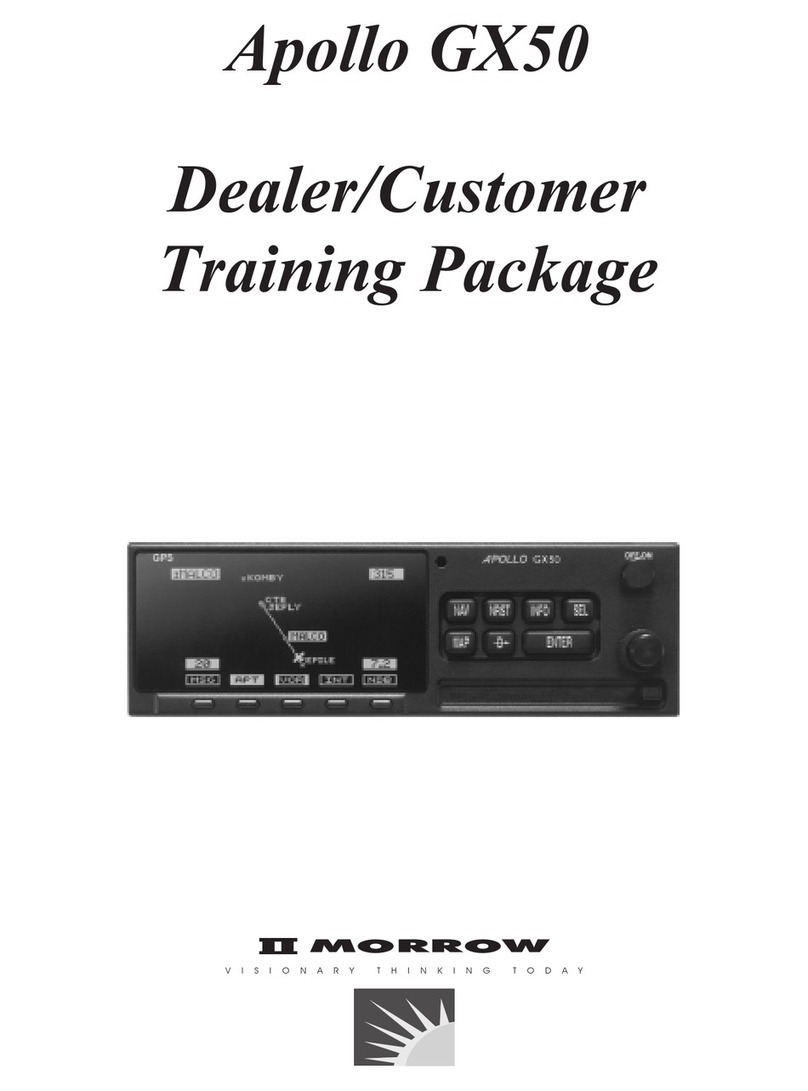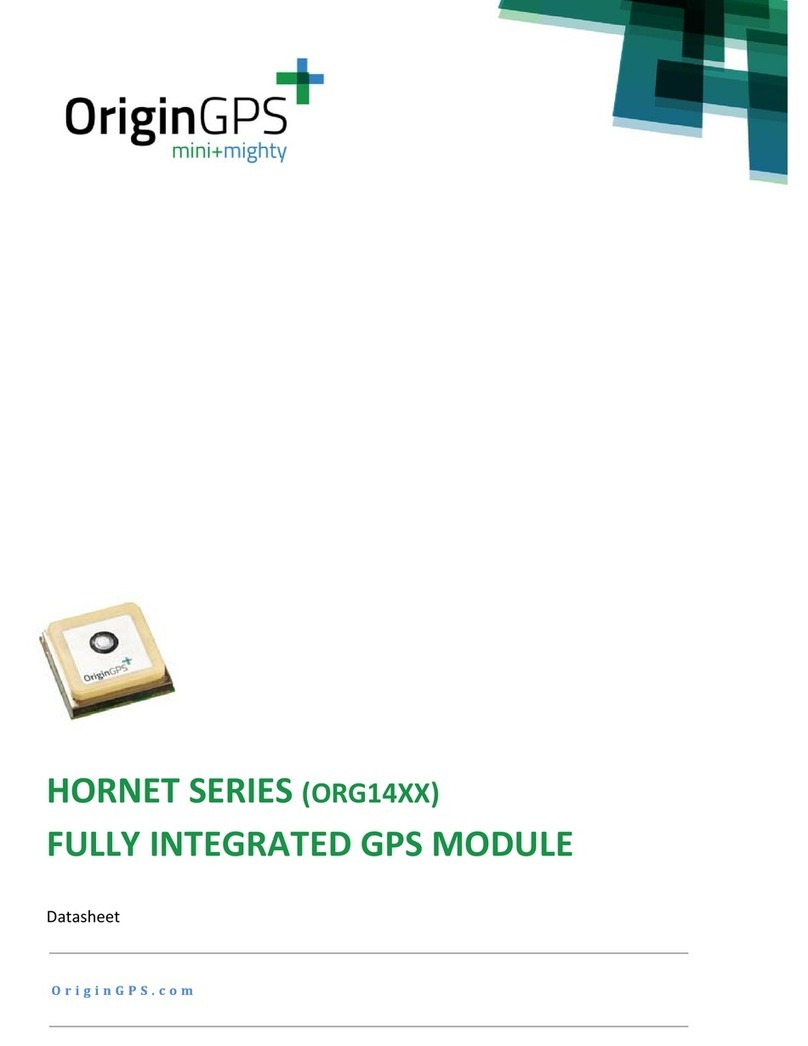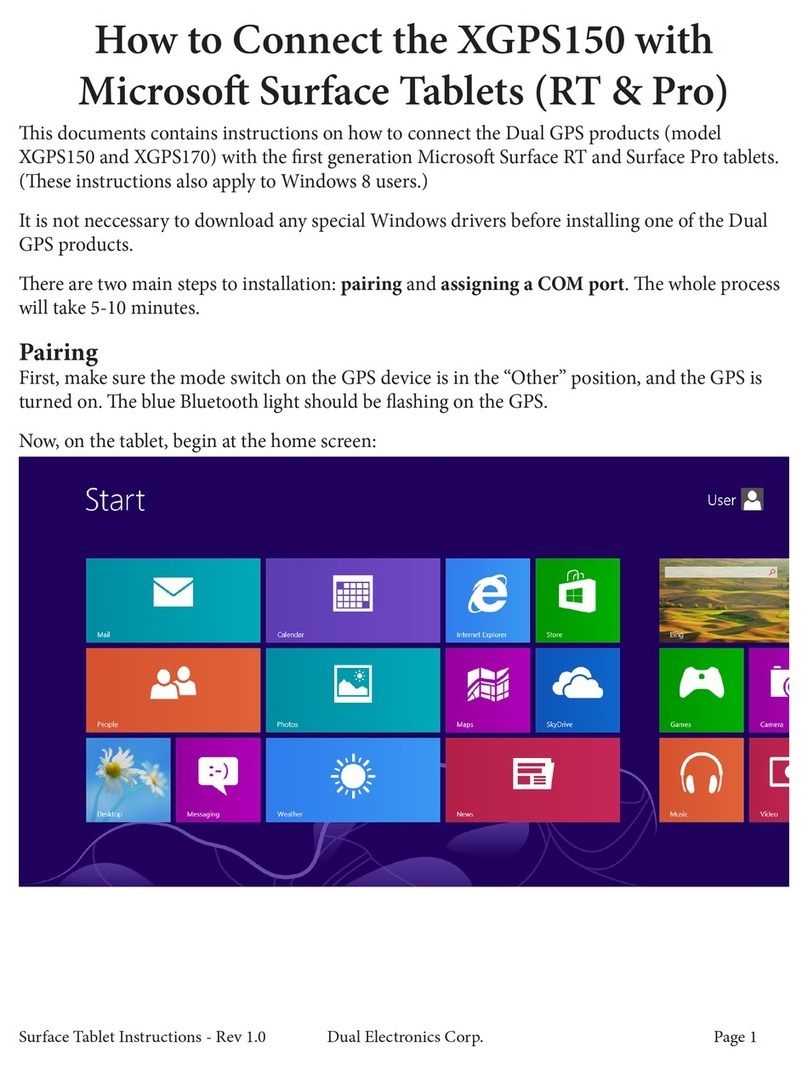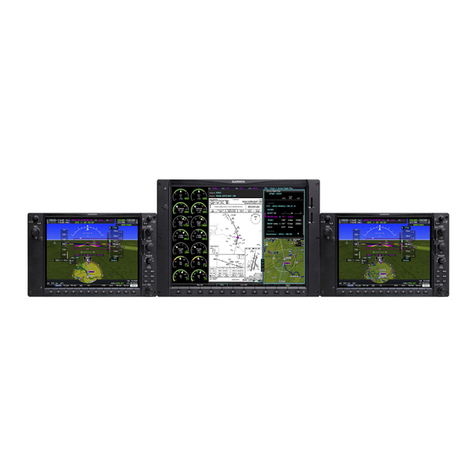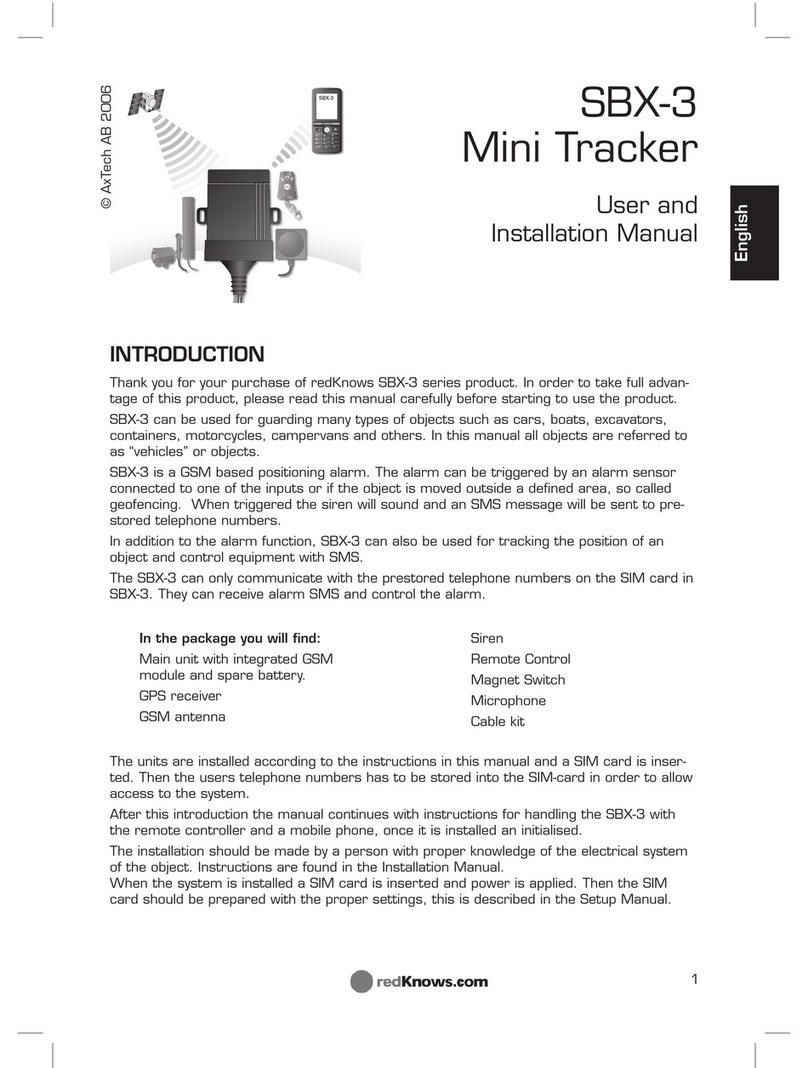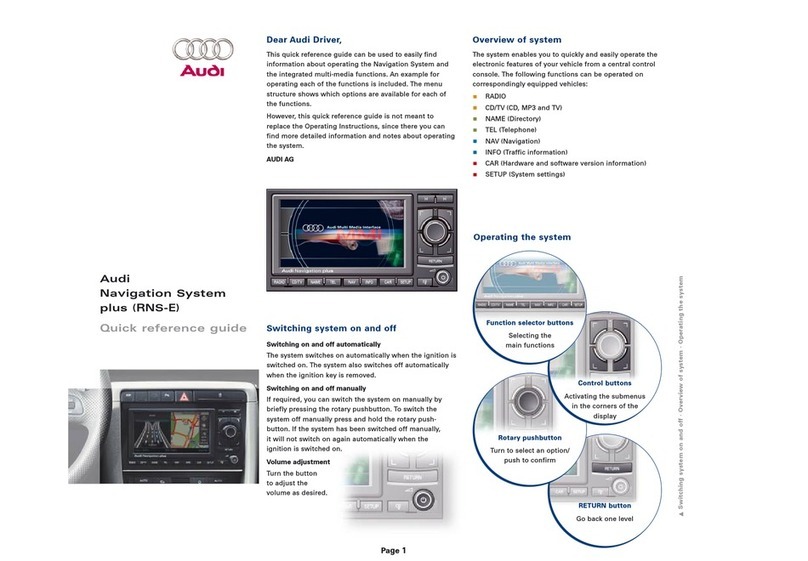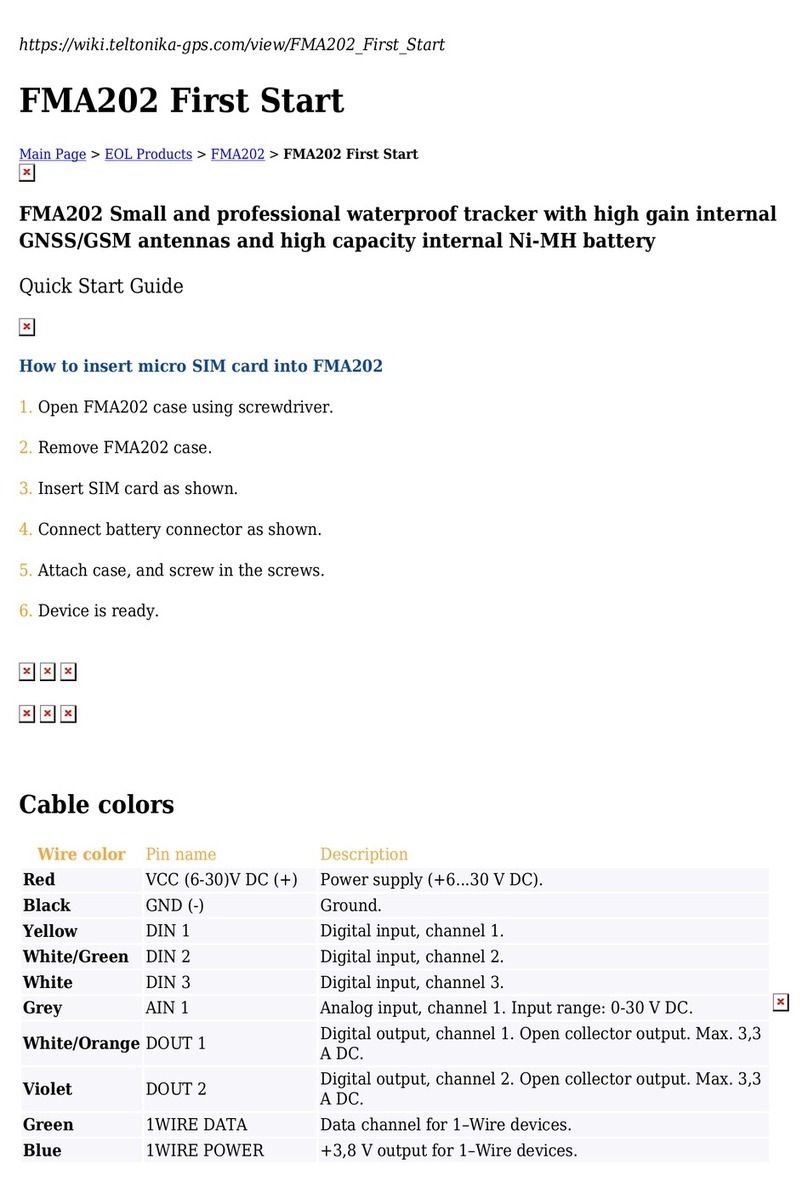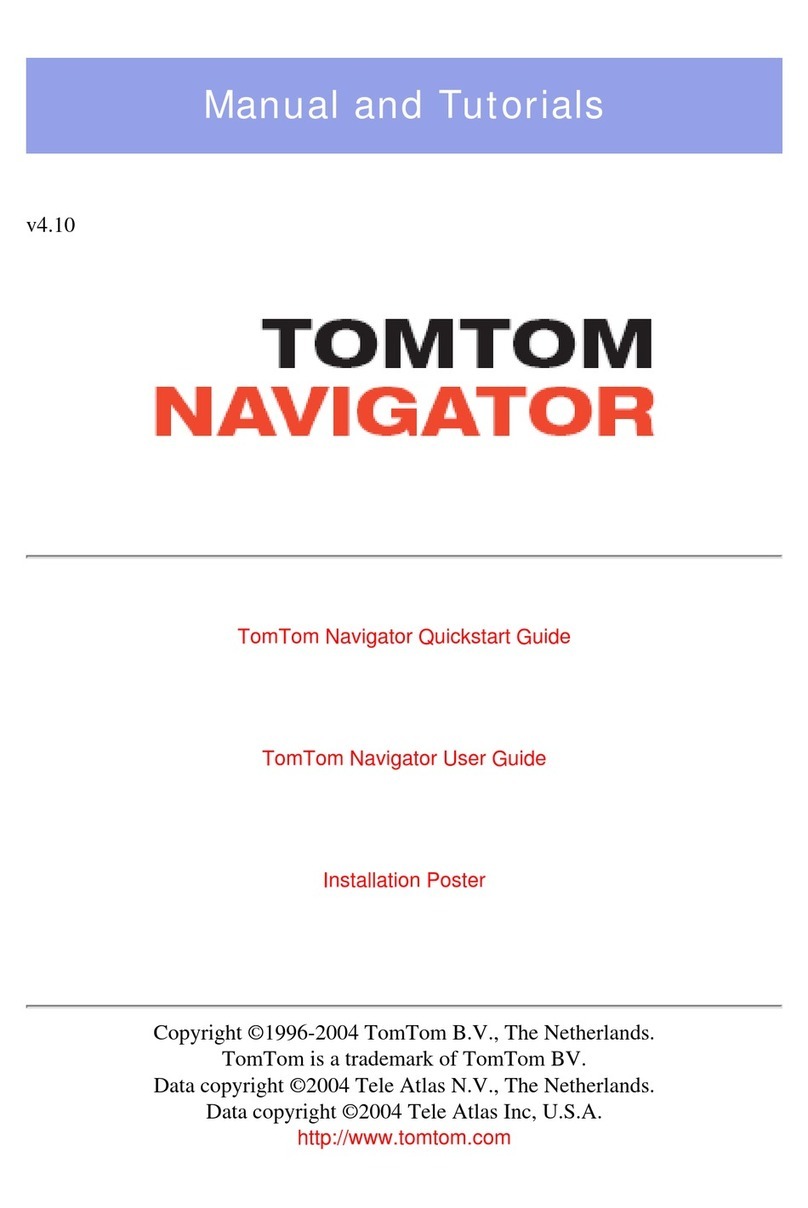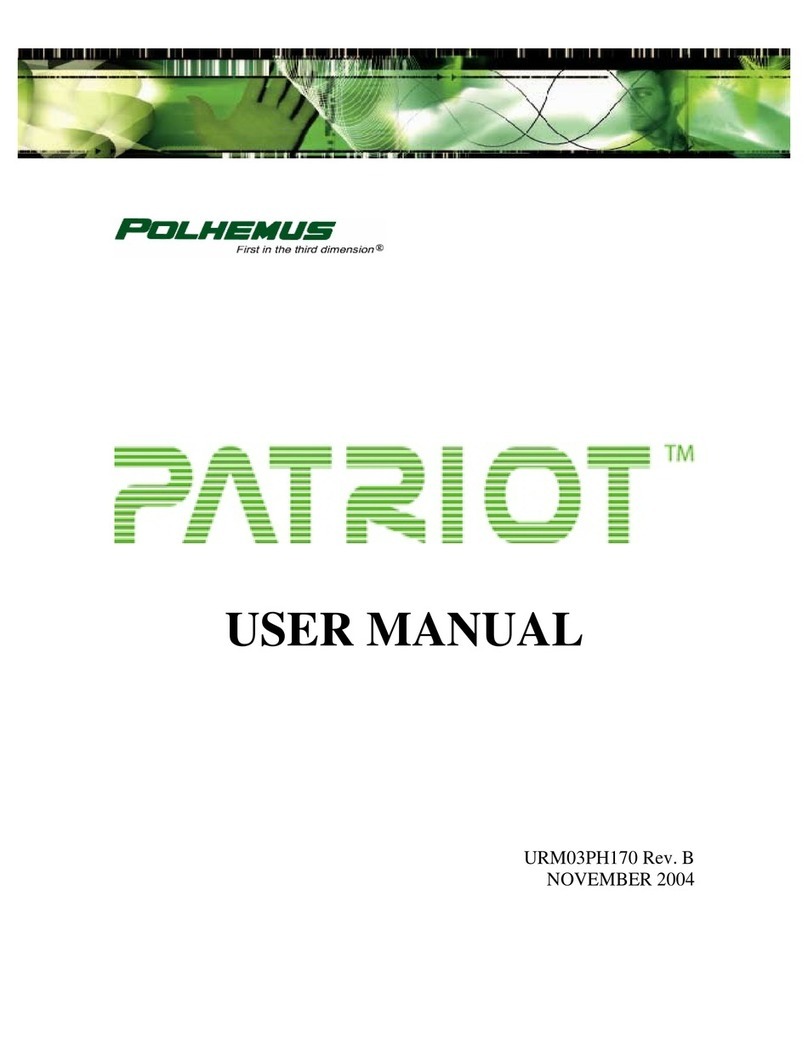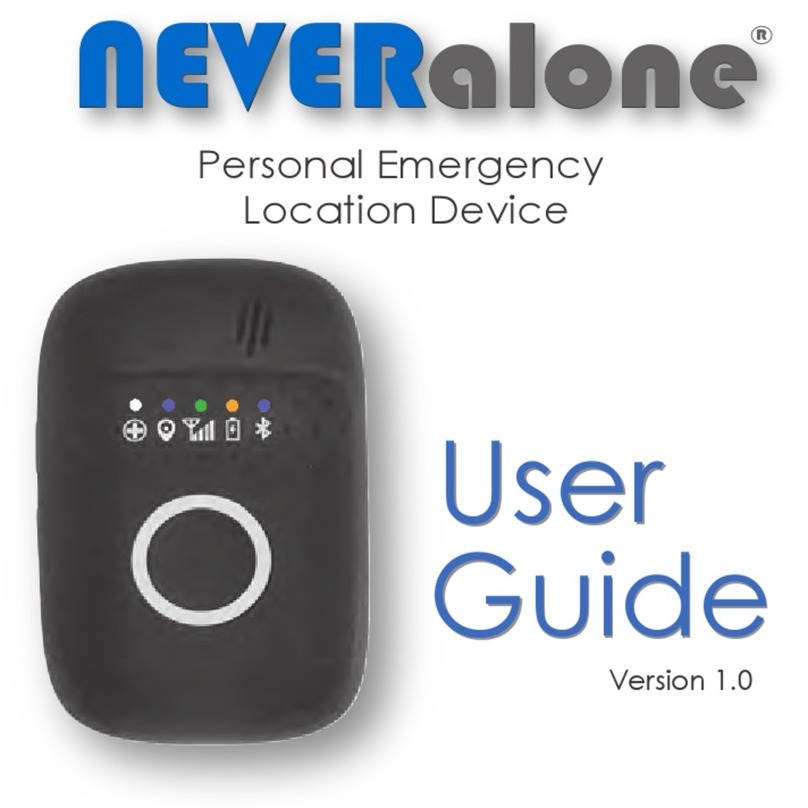II Morrow Inc. Apollo SL50 GPS User manual

Apolloâ
Model SL50 GPS
Model SL60 GPS / VHF COMM
Installation Manual
February 2002 560-0957-02

ã2002 by UPS Aviation Technologies, Inc. All rights reserved.
Printed in the USA
No part of this document may be transmitted, reproduced, or copied in any form or by any means
without the prior written consent of UPS Aviation Technologies, Inc. Due to UPS Aviation
Technologies’ commitment to constantly improve the quality and performance of our products,
information contained in this document is subject to change without notice.
UPS Aviation Technologies, II Morrow, Apollo, and Flybrary are registered trademarks of UPS
Aviation Technologies, Inc.
UPS Aviation Technologies, Inc. 2345 Turner Rd. SE
PO Box 13549 Salem, OR 97302
Salem, OR 97309 USA
Phone (503)581-8101
1-800-525-6726
In Canada 1-800-654-3415
FAX (503)364-2138

HISTORY OF REVISIONS
Revision Date Description
-- 2/24/97 Initial release.
-01 3/14/97 Change coax recommendation from RG-58 to RG-142B
-01a 9/23/99 Added new connector pins and crimping tools
-02 2/8/02 Added user set Comm functions. SW Version 1.1 and helicopter
environmental qualification
IMPORTANT NOTE
“The conditions and tests required for TSO approval of this article are minimum performance
standards. It is the responsibility of those desiring to install this article on or within a specific
type or class of aircraft to determine that the aircraft operating conditions are within TSO
standards. The article may be installed only if further evaluation by the applicant documents
an acceptable installation and is approved by the Administrator.”
Source: FAA TSO-C37d, TSO-C38d, TSO-C128, and TSO-C129
ORDERING INFORMATION
To receive additional copies of this publication, order part # 560-0957-01b, Apollo SL50/SL60
GPS / VHF COMM Installation Manual.
REFERENCE PUBLICATIONS
Following are other publications referenced in this guide. Apollo SL50/SL60 GPS/VHF
COMM User’s Guide, 560-0955-xx.

NOTES

Table of Contents
Apollo SL50 / SL60 Installation Manual i
TABLE OF CONTENTS
SECTION 1 - INTRODUCTION ................................................................................................ 1
ABOUT THIS MANUAL...................................................................................................................... 1
APOLLO SL50 / SL60 DESCRIPTION................................................................................................. 1
FEATURES ........................................................................................................................................ 3
SYSTEM CONFIGURATIONS ............................................................................................................... 4
VFR GPS NAVIGATION INSTALLATION......................................................................................................................4
IFR GPS NAVIGATION INSTALLATION .......................................................................................................................4
COMM TRANSCEIVER - SL60 .....................................................................................................................................5
DATABASE UPDATES........................................................................................................................ 5
REGULATORY COMPLIANCE ............................................................................................................. 5
UNPACKING THE EQUIPMENT ........................................................................................................... 6
PACKAGE CONTENTS........................................................................................................................ 6
OTHER REQUIRED MATERIALS ......................................................................................................... 7
SPECIAL TOOLS REQUIRED............................................................................................................... 7
LICENSE REQUIREMENTS.................................................................................................................. 7
SECTION 2 - INSTALLATION.................................................................................................. 9
PRE-INSTALLATION INFORMATION ................................................................................................... 9
INSTALLATION OVERVIEW................................................................................................................ 9
INSTALLATION CONSIDERATIONS ..................................................................................................... 9
MOUNTING CONSIDERATIONS ....................................................................................................................................9
MINIMUM SYSTEM CONFIGURATION ..........................................................................................................................9
HELICOPTER REQUIREMENTS .....................................................................................................................................9
EQUIPMENT MOUNTING ................................................................................................................... 9
MOUNTING TUBE INSTALLATION .............................................................................................................................10
UNIT INSERTION.......................................................................................................................................................11
UNIT REMOVAL........................................................................................................................................................11
ELECTRICAL CONNECTIONS............................................................................................................ 13
POWER .....................................................................................................................................................................13
AVIONICS OUTPUTS .................................................................................................................................................13
SERIAL INTERFACE...................................................................................................................................................13
SIMULATOR SELECT INPUT.......................................................................................................................................14
SPEAKER AND HEADPHONE OUTPUTS (SL60 ONLY) ................................................................................................14
MICROPHONE INPUTS (SL60 ONLY) .........................................................................................................................14
TRANSMIT KEY INPUT (SL60 ONLY)........................................................................................................................14
INTERCOM SELECTOR SWITCH (SL60 ONLY) ...........................................................................................................14
REMOTE FLIP/FLOP INPUT (SL60 ONLY) ..................................................................................................................14
ANTENNA INSTALLATION AND CONNECTIONS ................................................................................ 14
COMM ANTENNA (SL60 ONLY)...............................................................................................................................14
GPS ANTENNA ........................................................................................................................................................15
POST INSTALLATION CHECKOUT .................................................................................................... 22
TEST MODE CHECKOUT AND SETUP ........................................................................................................................22
GPS NAVIGATION CHECKOUT .................................................................................................................................24
VHF COMM CHECKOUT (SL60) ..............................................................................................................................25
FINAL SYSTEM CHECK ............................................................................................................................................25
SECTION 3 - SPECIFICATIONS ............................................................................................ 29
ELECTRICAL ................................................................................................................................... 29

Table of Contents
ii Apollo SL50 / SL60 Installation Manual
PHYSICAL .......................................................................................................................................29
ENVIRONMENTAL............................................................................................................................29
GPS RECEIVER PERFORMANCE ......................................................................................................30
AVIONICS OUTPUTS ........................................................................................................................31
ANNUNCIATOR REQUIREMENTS ......................................................................................................31
COMM RECEIVER PERFORMANCE (SL60 ONLY)..............................................................................32
COMM TRANSMITTER PERFORMANCE (SL60 ONLY) .......................................................................32
INTERCOM PERFORMANCE (SL60 ONLY) ........................................................................................33
CONTROL INPUTS ............................................................................................................................33
ANTENNA REQUIREMENTS..............................................................................................................33
GPS ANTENNA........................................................................................................................................................ 33
COMM ANTENNA..................................................................................................................................................... 33
SERIAL INTERFACE..........................................................................................................................33
REAR CONNECTOR PINOUT .............................................................................................................33
SECTION 4 - LIMITATIONS ...................................................................................................37
INSTALLATION ................................................................................................................................37
OPERATIONAL.................................................................................................................................37
APPENDIX A - TROUBLESHOOTING ..................................................................................39
CONTACTING THE FACTORY FOR ASSISTANCE ................................................................................40
APPENDIX B - PERIODIC MAINTENANCE ........................................................................41
LITHIUM BATTERY REPLACEMENT..................................................................................................41
EQUIPMENT CALIBRATION ..............................................................................................................41
REFERENCE OSCILLATOR ........................................................................................................................................ 41
CLEANING THE FRONT PANEL.........................................................................................................41
APPENDIX C - ENVIRONMENTAL QUALIFICATIONS...................................................43
APPENDIX D - ACCESSORIES ...............................................................................................45
FROM II MORROW ..........................................................................................................................45
APPENDIX E - SERIAL INTERFACE SPECIFICATIONS .................................................47
MOVING MAP OUTPUT ............................................................................................................................................ 47
COMM DATA OUTPUT ............................................................................................................................................. 50
REMOTE LOCALIZER LIST ........................................................................................................................................ 52

Table of Contents
Apollo SL50 / SL60 Installation Manual iii
LIST OF TABLES
TABLE 1 PACKAGE CONTENTS ........................................................................................................ 6
TABLE 2 COMM INTERFACE CONNECTOR PINOUT ......................................................................... 34
TABLE 3 NAVIGATION INTERFACE CONNECTOR PINOUT ............................................................... 35
TABLE 4 TROUBLESHOOTING GUIDE ............................................................................................. 39
TABLE 5 RS-232 SERIAL INTERFACE SELECTIONS ........................................................................ 47
TABLE 6 MOVING MAP ASCII NAVIGATION DATA....................................................................... 48
TABLE 7 MOVING MAP BINARY ROUTE DATA.............................................................................. 49
LIST OF ILLUSTRATIONS
FIGURE 1 SL50 FRONT PANEL ........................................................................................................ 2
FIGURE 2 SL60 FRONT PANEL ........................................................................................................ 2
FIGURE 3 - FULL STACK MOUNTING TUBE SPACING ...................................................................... 10
FIGURE 4 - MOUNTING FRAME ASSEMBLY..................................................................................... 12
FIGURE 5 CABLE ROUTING............................................................................................................ 12
FIGURE 6 REAR COAX CONNECTOR ASSEMBLY ............................................................................ 16
FIGURE 7 TNC COAX CONNECTOR ASSEMBLY............................................................................. 17
FIGURE 8 POWER AND AVIONICS CONNECTIONS ........................................................................... 18
FIGURE 9 RS-232 SERIAL INTERFACE CONNECTIONS.................................................................... 19
FIGURE 10 SL60 COMM WIRING DIAGRAM ................................................................................... 20
FIGURE 11 SL60 TYPICAL AUDIO PANEL CONNECTIONS .............................................................. 21
FIGURE 12 UNIT DIMENSIONS ....................................................................................................... 30
FIGURE 13 MOVING MAP DATA OUTPUT ...................................................................................... 50

Table of Contents
iv Apollo SL50 / SL60 Installation Manual
NOTES

Introduction
Apollo SL50 / SL60 Installation Manual 1
SECTION 1 - INTRODUCTION
ABOUT THIS MANUAL
This manual describes the installation of the Apollo SL50 GPS and SL60 GPS/Comm units. It
is intended for use by persons certified by the Federal Aviation Administration (FAA) to
install aircraft navigation devices. It includes installation and checkout procedures for the
SL50 and SL60 units to standards described in FAA advisory circulars AC 20-138 (for GPS)
and AC 20-67B (for comm).
The SL50 and SL60 units are equivalent except for the SL50 does not include the VHF
Comm. Throughout this manual, references to the SL50/60 are for both the SL50 and SL60.
Provides an introduction to the Apollo SL60 unit. TSO certification information
is also included in this section.
Includes installation and checkout procedures.
Includes complete specifications.
Includes limitations for the equipment and installation.
Includes troubleshooting information.
Includes periodic maintenance requirements.
Includes the environmental qualification form.
Includes information on accessories.
Includes serial data specifications.
APOLLO SL50 / SL60 DESCRIPTION
The Apollo SL50 GPS is a TSO-C129 GPS supplemental navigation receiver for IFR enroute
and terminal operation. It includes a built-in data base that can be updated through a serial
port.
The Apollo SL60 GPS/Comm includes the same GPS capabilities as the SL50 and includes a
760 channel VHF Comm transceiver.
The Apollo SL50 and SL60 are two members of the Apollo slimline series which include the
SL40 Comm, the SL50 GPS, and the SL60 GPS/Comm.
Section 1
Section 2
Section 3
Section 4
Appendix A
Appendix B
Appendix C
Appendix D
Appendix E

Introduction
2 Apollo SL50 / SL60 Installation Manual
Figure 1 SL50 Front Panel
Figure 2 SL60 Front Panel

Introduction
Apollo SL50 / SL60 Installation Manual 3
FEATURES
The GPS navigation features for the SL50 GPS and SL60 GPS/Comm include:
·32 character high-intensity alphanumeric LED display
·Automatic display intensity
·Back-lit buttons
·Simple “Direct-To” navigation
·Built-in data base updatable through a serial port
·Nearest waypoint search (includes airports, VORs, NDBs, intersections, and user
waypoints)
·Remote waypoint search
·Navigation displays -
-Lat/Lon to 0.01 minute
-Bearing and distance to waypoint
-Ground speed and track angle
-Desired track and distance between waypoints
-Cross track error with numeric and graphic CDI
-Display of the “TO” waypoint ident
-ETE and ETA to the “TO” and destination waypoints
·Automatic waypoint sequencing
·Built-in simulator for trip planning and training
·User definable navigation pages with auto sequencing
·10 flight plans of 20 legs each
·200 user waypoints created by lat/lon or by radial/distance from a reference waypoint
·User selectable units -
-nm or km for distance displays
-knots or kph for speed displays
·Real time clock (time and date) in UTC
·Countdown timer
·Flight timer
·Automatic or manual magnetic variation
·Parallel track offset
·Alerts for -
-Loss of navigation
-Arrival at waypoint
-Special use airspace
·Full range input supply voltage
The VHF Comm features of the SL60 GPS/Comm include:
·760 channels
·Frequency range of 118.000 to 136.975MHz
·Active and standby frequency display
·Transmit status indicator
·Stuck mic time-out

Introduction
4 Apollo SL50 / SL60 Installation Manual
·Frequency monitor function
·Weather channels (only in Americas database)
·Built-in intercom function
·Frequency memory and recall functions
-from navigation data base
-eight last used
-eight user stored
·Two microphone inputs
·12 watt audio amplifier
·Remote flip/flop input
SYSTEM CONFIGURATIONS
The SL50 and SL60 can be installed in several configurations based upon individual
requirements. This includes with or without the comm transceiver, and VFR or IFR GPS
navigation. This section defines the minimum requirements.
VFR GPS NAVIGATION INSTALLATION
When installed for VFR operation, the SL50/60 requires only the following minimal
connections.
·an A-33 GPS antenna
·power input
The SL50/60 can also be connected to other external devices such as:
·an external non-numeric indicator, such as a CDI or HSI
·external lamp annunciators including “MSG” and “PTK”
·an “OBS/HLD” external annunciator (with switch)
·an autopilot
·a moving map display connected to an RS-232 serial output
When the SL50/60 is installed for VFR, a placard stating “GPS Limited to VFR Use Only” or
an FAA approved equivalent statement must be placed next to the primary indicator
IFR GPS NAVIGATION INSTALLATION
When installed for IFR operation, the SL50/60 requires connections to several external
indicators. The minimum connections for IFR operation is as follows.
·an A-33 GPS antenna
·power input
·an external non-numeric indicator, such as a CDI or HSI
·external lamp annunciators including “MSG” and “PTK”
The following additional connections are recommended, but not required.
·an “OBS/HLD” external annunciator (with switch)
The SL50/60 can also be connected to other external devices such as:
·an autopilot
·a moving map display connected to an RS-232 serial output

Introduction
Apollo SL50 / SL60 Installation Manual 5
COMM TRANSCEIVER - SL60
For standalone installations, the comm requires connections to:
·a standard comm antenna
·a microphone (or microphones)
·a speaker or headphone
·power input
These items may be installed dedicated to the SL60 comm, or by connection to an audio
panel.
DATABASE UPDATES
The SL50/60 includes a built-in Flybrary database stored in flash memory. The database can
be updated through the RS-232 connection on the rear of the unit using a PC. The Waypoint
Manager program (available from II Morrow) is required.
The database can be updated by removing the SL50/60 from the aircraft and connecting it to a
PC and providing a 10 to 40 volt DC power source. A cable assembly (see page 45) is
available from II Morrow for this purpose.
To update the database. connect the SL50/60 to power and the PC. On the SL50/60, press SYS,
rotate the LARGE knob to select the “DATABASE UPDATE:” page, then press ENT. Follow the
Waypoint Manager instructions for downloading the new database. The SL50/60 will display
the programming status, when it is complete, and if an error occurs.
Contact the II Morrow factory for information on databases available for the SL50/60.
REGULATORY COMPLIANCE
The Apollo SL60 is designed and tested to meet the following TSOs:
FAA TSO-C37d for transmit
FAA TSO-C38d for receive
FAA TSO-C128 for unintentional transmission (stuck mic)
FAA TSO-C129 for GPS navigation
The Apollo SL50 is designed and tested to meet the following TSOs:
FAA TSO-C129 for GPS navigation
The Apollo SL60 comm complies with the FCC requirements specified in:
CFR 47, Part 87, Aviation Services, Subpart D, Technical Requirements
The Apollo SL50 and SL60 comply with the FCC requirements specified in:
CFR 47, Part 15, Radio Frequency Devices, Subpart B, Unintentional Radiators
The Apollo SL50/60 software is designed and tested to RTCA/DO-178B, level C.
Note: Un-authorized changes or modifications to the SL50 or SL60 may void
the compliance to required regulatory agencies and authorization for continued
equipment usage.

Introduction
6 Apollo SL50 / SL60 Installation Manual
UNPACKING THE EQUIPMENT
Carefully unpack the equipment. Visually inspect the package contents for any evidence of
shipping damage. Retain all shipping containers and packaging material in case reshipment is
necessary.
PACKAGE CONTENTS
As shipped from the II Morrow factory, the Apollo SL50/60 package includes most items
necessary for installation other than supplies normally available at the installation shop, such
as wire and cable ties, and required input and output equipment. The standard items included
in the package are listed in Table 1.
Table 1 Package Contents
Part # Description Qty
SL50 SL60
Units
430-6040-4xx SL50 GPS 1
430-6040-6xx SL60 GPS / Comm 1
Install kits Part number: 424-2006- -4xx -6xx
162-0100 or
162-1575
15 pin dsub connector shell 1
162-0103 or
162-1577
37 pin dsub connector shell 1 1
162-1008 Right angle coax plug 1 2
162-1060 TNC coax connector 1 1
202-0001 Cable tie 2 4
204-0037 Edge grommet 6” 6”
204-2100 Shoulder bushing 2 4
221-0400 4-40 x 1/4 SS pan head Phillips machine screw with lock
washer
88
224-0404 4-40 x 1/4 SS flat head Phillips machine screw 2 4
245-0022 or
245-0027
Crimp contact for dsub, 20 to 24 awg wire 37 52
310-5181-xx Mounting frame 1 1
310-5187-xx Connector mounting plate 1 1
998-0048 3/32 hex driver 1 1
Manual kits Part number: 564-0064- -4xx -6xx
560-0955-xx SL50 / SL60 User’s Manual 1 1
560-0957-xx SL50 / SL60 Installation Manual 1 1
560-9002 Binder, 5½x 8½x ¾, 3 ring 1 1
561-0235-xx SL50 / SL60 Quick Reference Guide 1 1
Accessories
560-0949 A-33 Installation Guide 1 1
590-1104 A-33 GPS Antenna 1 1
Note: Package contents may vary depending on how the unit is ordered.

Introduction
Apollo SL50 / SL60 Installation Manual 7
OTHER REQUIRED MATERIALS
The SL50/60 is intended for use with standard aviation accessories. External devices required
for various installations are listed in the System Configurations section on page 4. Depending
upon the installation, this will include items such as:
·annunciators
·a CDI or HSI
·a comm antenna
·a microphone(s)
·a speaker or headphone
SPECIAL TOOLS REQUIRED
Crimp Tool
A crimp tool meeting MIL specification M22520/1-01 and a positioner/locater are required to
ensure consistent, reliable crimp contact connections for the rear 15 pin connector. These tools
are available from:
For pin p/n 162-0100
Astro Tool Corp. Phone (503) 642-9853
21615 SW TV Highway Fax (503) 591-7766
Beaverton, OR 97006
Crimp tool: Astro Tool part #615708
Positioner: Astro Tool part #616356
For pin p/n 162-1575
ITT Cannon Phone (714) 261-5300
1851 E. Deere Ave. Fax (714) 575-8324
Santa Ana, CA 92705-6500
Insertion tool: ITT part # 274-7006-000 (Desc. CIET-20HD)
Regular duty Crimp tool: ITT part #995-0001-585 (Desc. M22520/1-01)
Regular duty Locator tool: ITT part #995-0001-244 (Desc. TH25)
Heavy duty Crimp tool: ITT part #995-0001-584 (Desc. M22520/2-01)
Heavy duty Locator tool: ITT part #995-0001-604 (Desc. M22520/2-08)
LICENSE REQUIREMENTS
An aircraft radio station license is required for operation of the SL60 comm transmitter once
installed in the aircraft. An application must be submitted on FCC Form 404, which may be
obtained from the FCC in Washington, DC, or any of its field offices. Procedures for
applications are in CFR 47, Part 87, Aviation Services, Subpart B, Applications and Licenses.

Introduction
8 Apollo SL50 / SL60 Installation Manual
NOTES

Installation
Apollo SL50 / SL60 Installation Manual 9
SECTION 2 - INSTALLATION
This section describes the installation of the SL50 and SL60 including mounting, wiring, and
connections. A post installation check-out procedure is included at the end of this section.
PRE-INSTALLATION INFORMATION
Always follow good avionics installation practices per FAA Advisory Circulars (AC) 43.13-
1A, 43.13-2A, AC 20-138, and AC 20-67B, or later FAA approved revisions of these
documents.
Follow the installation procedure in this section as it is presented for a successful installation.
Read the entire section before beginning the procedure. Perform the post installation check-
out before closing the work area in case problems occur.
INSTALLATION OVERVIEW
A successful installation should start with careful planning including determination of
mounting location for the SL50/60, antenna mounting, connections to microphones, speakers,
and headphones, cable routing, and other required modifications. Once the mounting location
has been determined, prepare the mounting frame for installation. It may be easier to complete
the wiring harness and attach the connectors to the mounting frame before installing the
mounting frame.
INSTALLATION CONSIDERATIONS
MOUNTING CONSIDERATIONS
The SL50/60 is designed to mount in the avionics stack in the aircraft instrument panel within
easy view and reach of the pilot. The standard package includes a mounting frame for ease of
mounting, connections, and service of the unit. Allow an additional one inch clearance to the
rear of the mounting frame for connectors and cables.
For typical installations, the SL50/60 does not require external cooling. When mounting the
unit, leave a clearance of 1/8 to 1/4 inch between avionics to allow for air circulation.
MINIMUM SYSTEM CONFIGURATION
The minimum system configuration and external connections requirements are described in
the System Configurations section on page 4.
HELICOPTER REQUIREMENTS
The SL60 is qualified for helicopter installation with certain mount tube and SL60
configurations (see Section 4 - Limitations).
EQUIPMENT MOUNTING
Once the cable assemblies have been made, attach the 15 and 37 pin d-sub and coaxial cable
connectors to the rear connector mounting plate and the mounting frame as illustrated in Figure 4
and

Installation
10 Apollo SL50 / SL60 Installation Manual
Figure 5. Route the wiring bundle as appropriate. The rear connector plate should be attached to
the mounting frame before installing the frame in the instrument panel. The rear connector
plate can be used to tie down the cable assemblies. Use the supplied edge guard to protect the
cable from sharp edges. Connect the shield grounds directly to the connector mounting plate.
Once the cable assemblies, the connector mounting plate, and the mounting frame are
assembled, install the mounting frame assembly in the instrument panel. Be sure to use low
profile head screws so the unit will slide in and out freely. Attach the front of the mounting
frame to the instrument panel. Use support brackets to attach the rear of the frame to the
aircraft.
MOUNTING TUBE INSTALLATION
Care must be taken when installing the mounting tube to ensure you can properly insert and
secure the unit. There must be a minimum vertical spacing of 0.040 inches between units to
prevent interference with the cam locking mechanisms. Mounting tubes with clearance
dimples help maintain the proper clearance. The mounting tube must be installed with the
clearance dimples pointing up.
Figure 3 - Full Stack Mounting Tube Spacing
The mounting tube should be flush to the instrument panel and allow sufficient clearance for the
back of the bezel of the unit to mount flush to the mounting tube. Sufficient clearance must exist
in the instrument panel opening to allow ease of insertion and removal of the unit. If the back

Installation
Apollo SL50 / SL60 Installation Manual 11
of the unit bezel does not mount flush to the mounting tube, the connector may not
engage fully.
Secure the mounting tube to the instrument panel structure. Mounting screw heads must not
protrude into the mounting tube. Be sure to use the appropriate screws so the unit will slide in
and out freely. The screws attaching the mounting tube to the instrument panel structure must
not interfere with the insertion of the unit. Failure to prevent interference will result in damage
to the unit or prevent its insertion. Take care that the mounting tube is not distorted when it is
attached to the instrument panel and structural supports. Shims may be necessary to properly
install the mounting tube. If the mounting tube is distorted out of square, the unit may either bind
when being inserted or the cam lock may not engage.
UNIT INSERTION
Position the cam lock as shown below. The front lobe of the cam should be vertical. The cam
lock mechanism should be fully unscrewed (turned counter-clockwise). Slide the unit into the
frame. Turn (clockwise) and carefully hand-tighten (4 in-lb max.) the cam lock mechanism
using only the 3/32" hex driver provided in the installation package. Using a larger tool than
the one provided makes it easy to exceed the allowable torque on the cam lock resulting in
damage to the unit. The unit will be pulled into the frame securing the unit and the connectors
will fully engage. Do NOT overtighten. The back of the bezel must only be flush to the
mounting tube. If the cam lock is hard to turn or the unit does not seat fully, the unit is
probably binding and the mounting tube should be checked.
UNIT REMOVAL
To remove the unit from the mounting frame, turn the screw counter-clockwise with the hex
driver to unscrew the cam lock mechanism. The unit will begin to pull away from the
mounting tube. Turn the screw until slight resistance is felt and then pull the unit from the
frame. Do not exert excessive turning force at the end of the cam lock travel or the unit
may be damaged. With the cam lock fully disengaged, pull the unit straight out holding onto
the sides of the bezel. It is not recommended that you pull the unit out by the rotary knobs. No
special extraction tools are required, if the mounting tube is properly installed.

Installation
12 Apollo SL50 / SL60 Installation Manual
Figure 4 - Mounting Frame Assembly
Figure 5 Cable Routing
This manual suits for next models
3
Table of contents
Other II Morrow Inc. GPS manuals
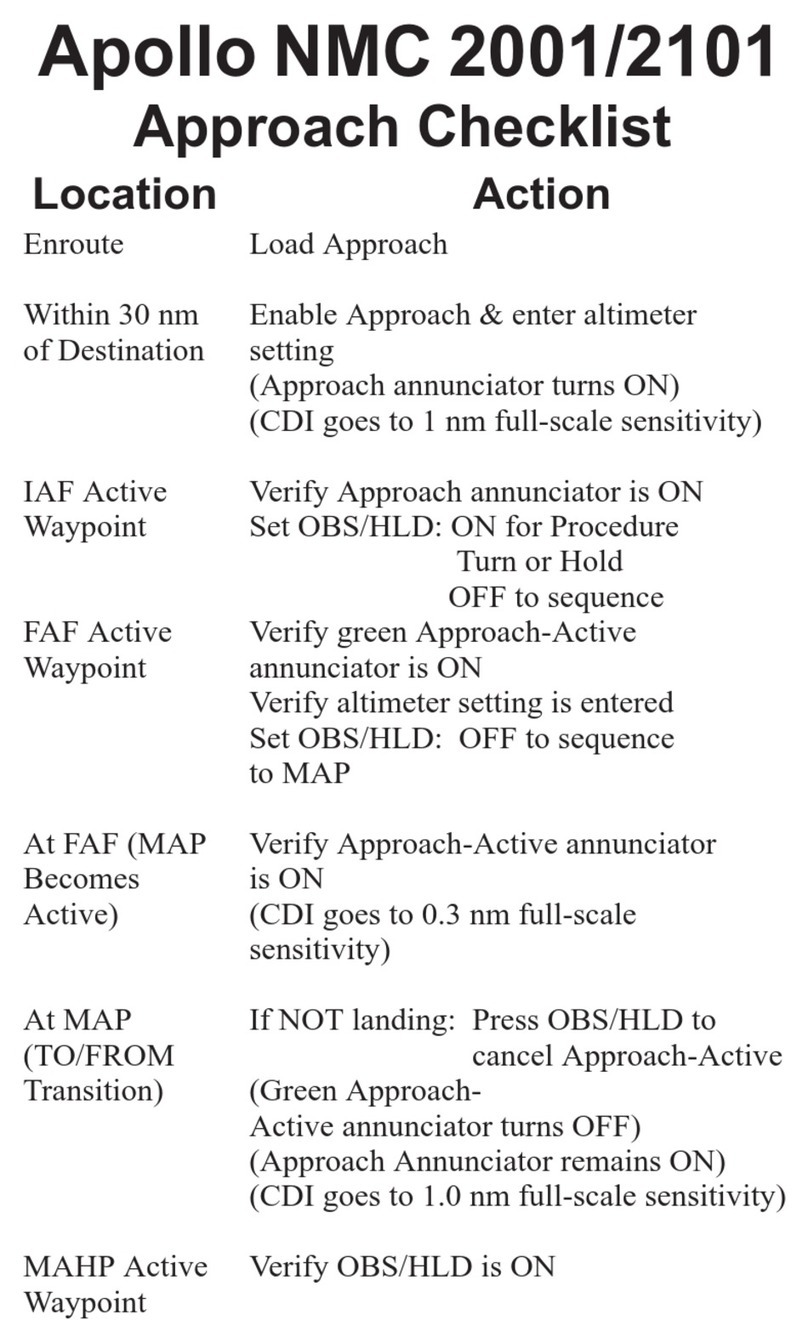
II Morrow Inc.
II Morrow Inc. Apollo NMC 2001 User manual
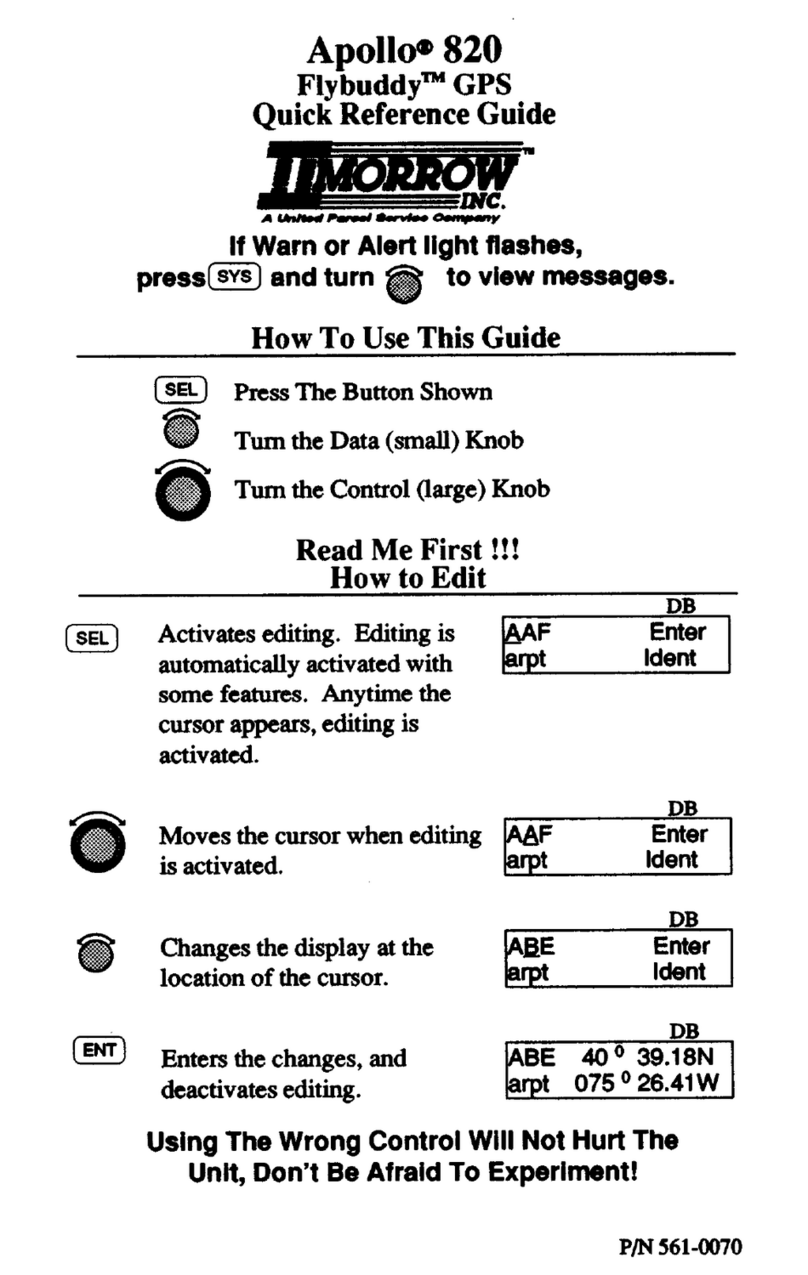
II Morrow Inc.
II Morrow Inc. Apollo 820 User manual
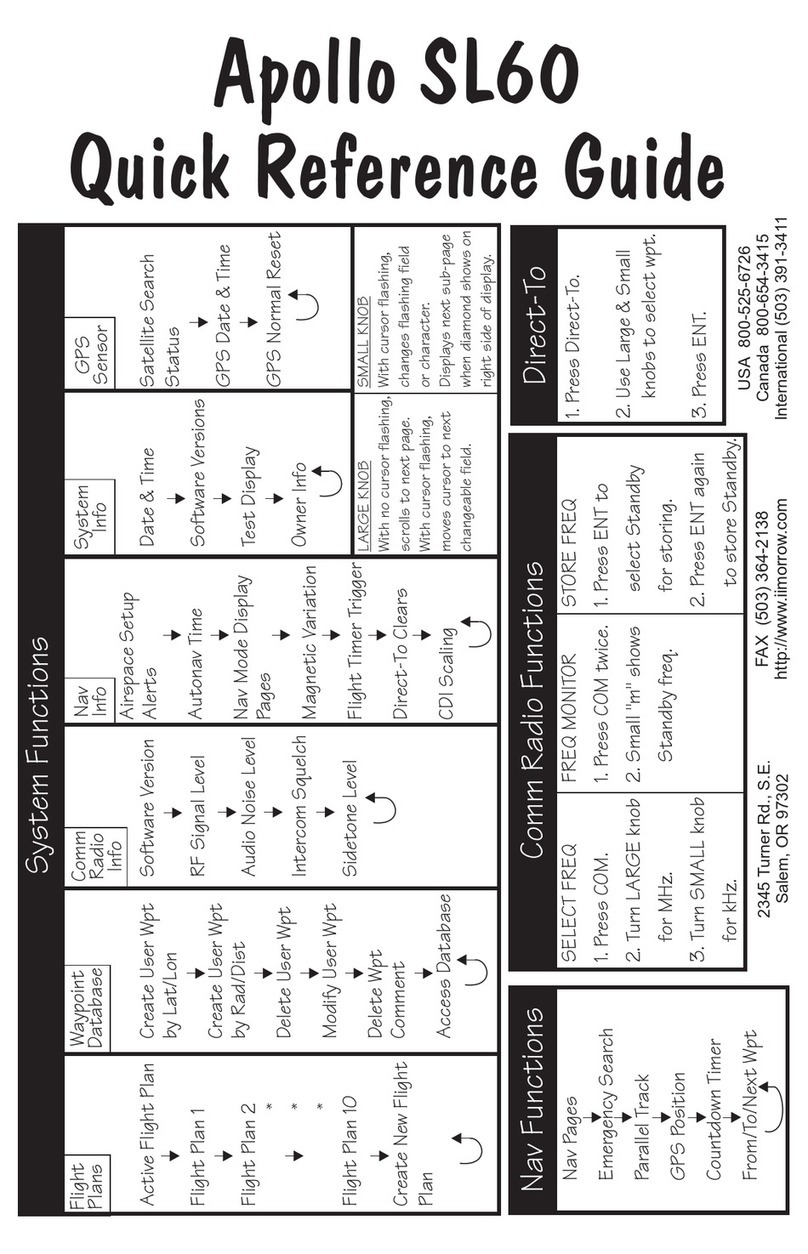
II Morrow Inc.
II Morrow Inc. Apollo SL60 User manual
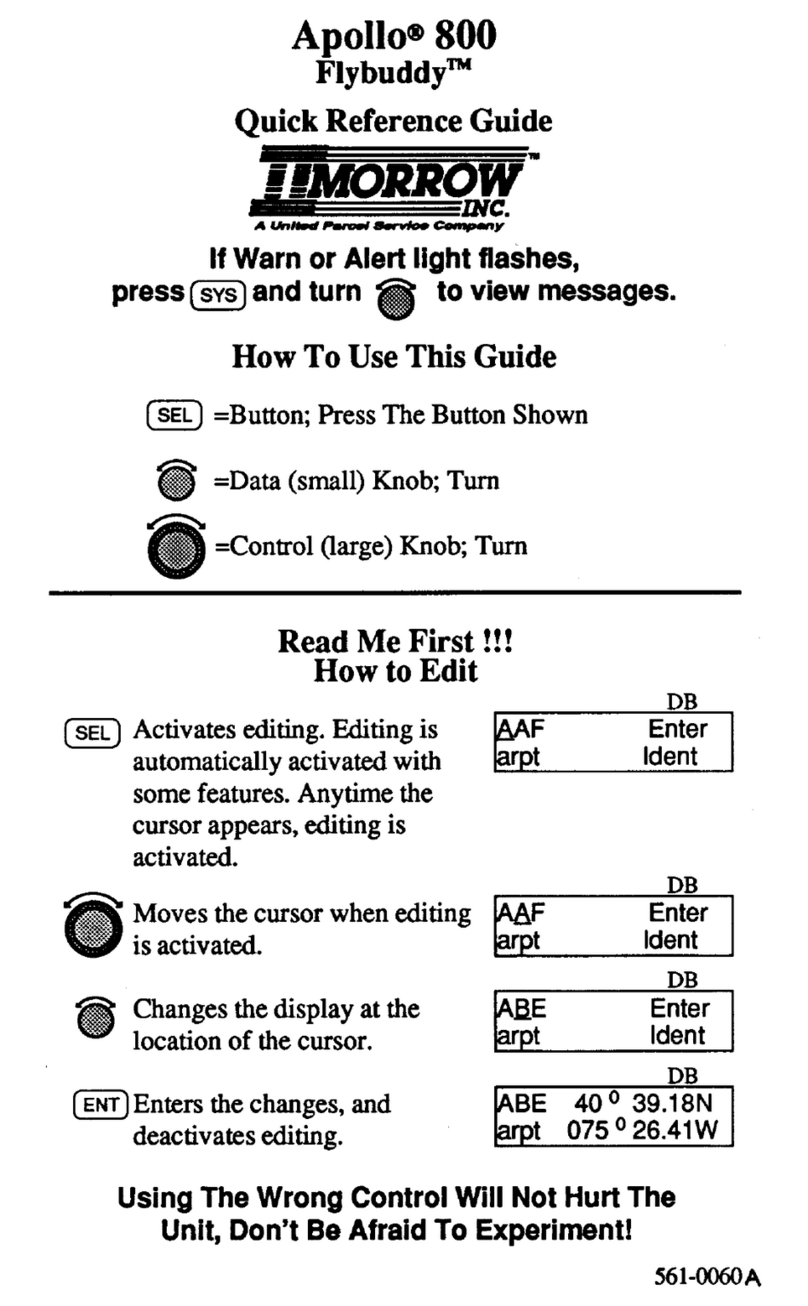
II Morrow Inc.
II Morrow Inc. Apollo 800 User manual
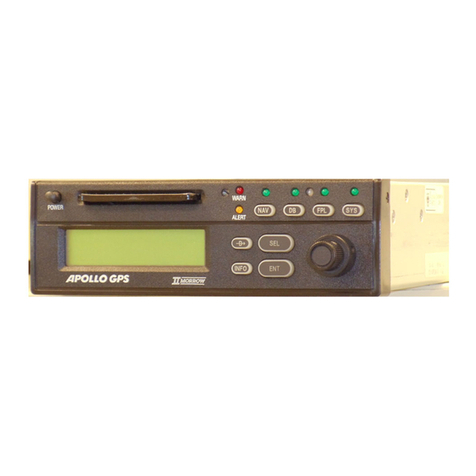
II Morrow Inc.
II Morrow Inc. Apollo 820 Manual
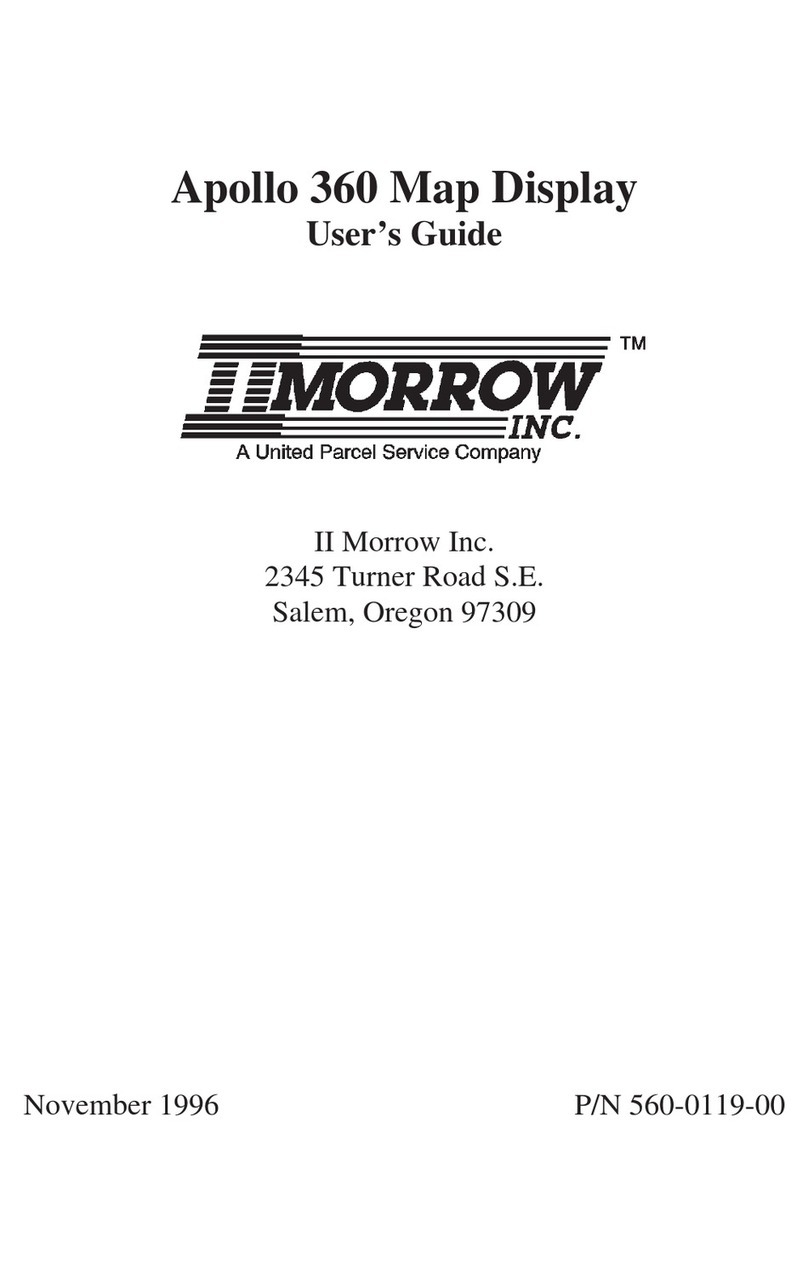
II Morrow Inc.
II Morrow Inc. Apollo 360 MAP User manual
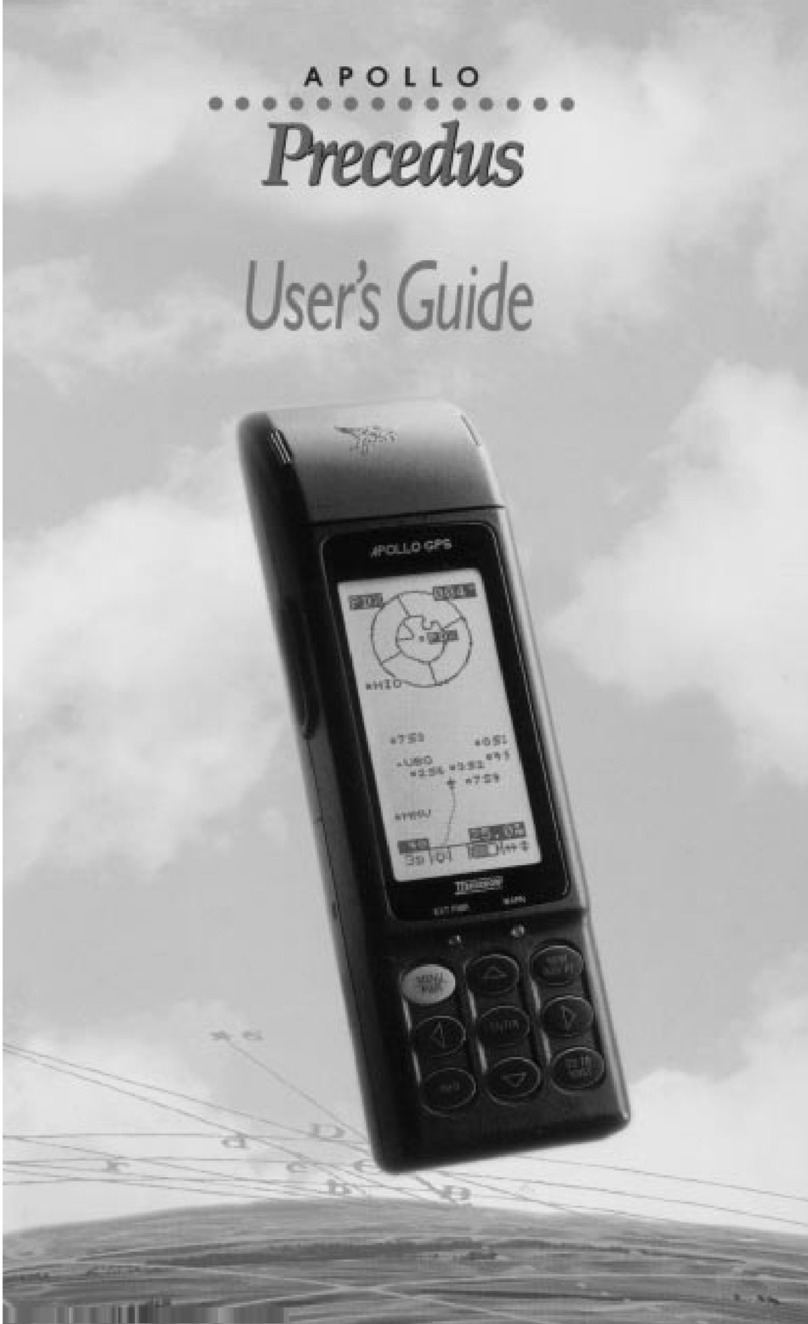
II Morrow Inc.
II Morrow Inc. Precedus User manual
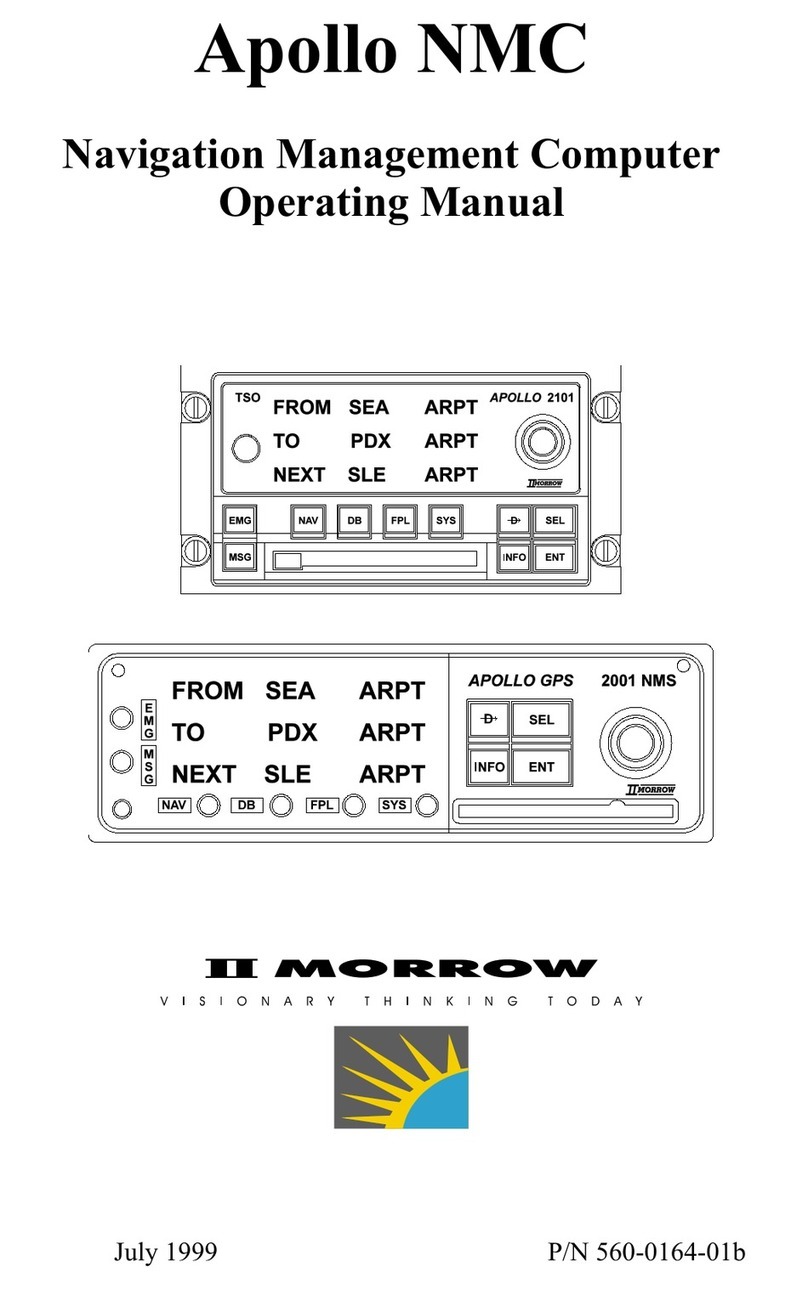
II Morrow Inc.
II Morrow Inc. Apollo NMC 2001 User manual
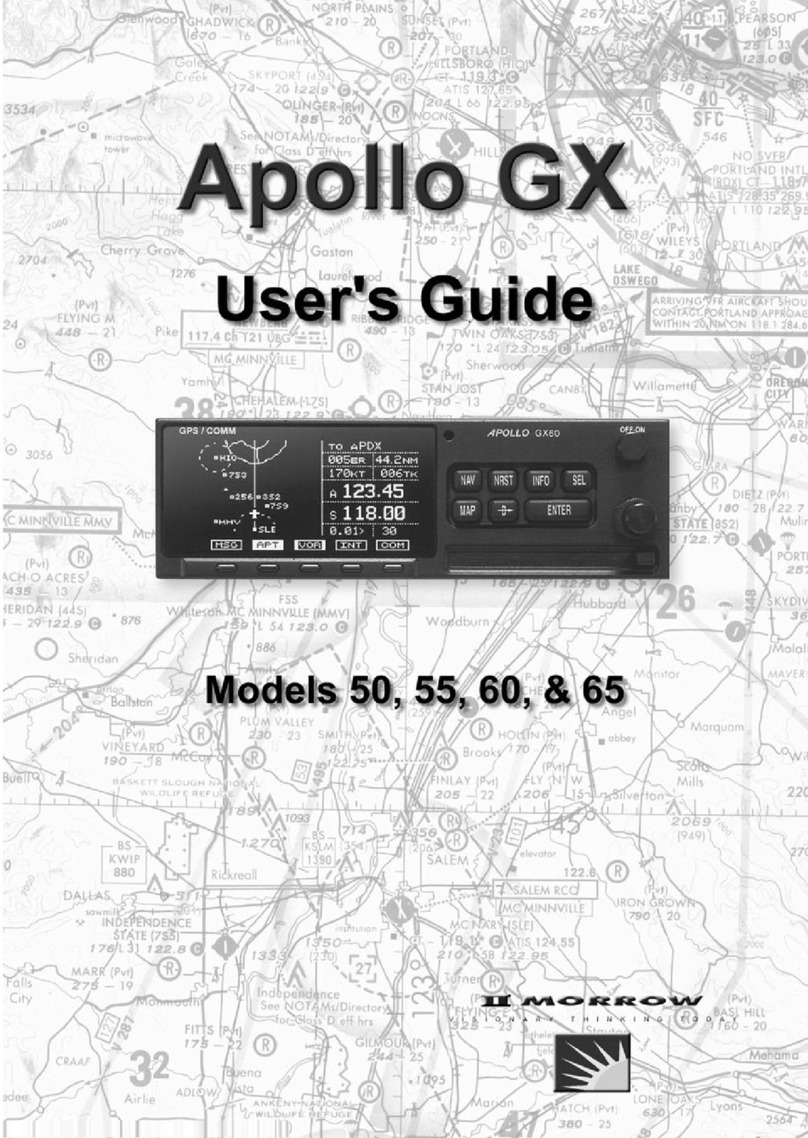
II Morrow Inc.
II Morrow Inc. 50 User manual
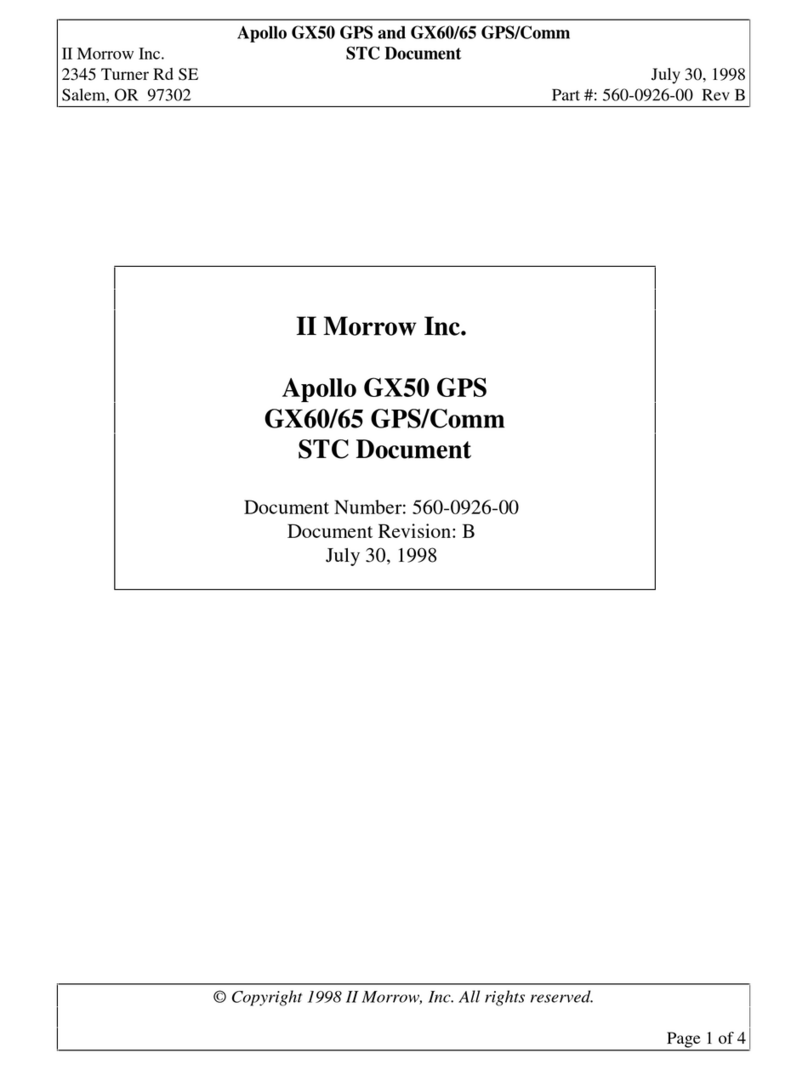
II Morrow Inc.
II Morrow Inc. Apollo GX 50 User manual

